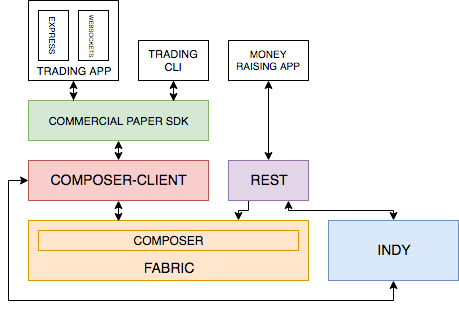commercial-paper-starter-kit
Development Flow
This repo is designed to provide an example of using blockchain tech, within a larger full-stack application. Centred around the provision of a Commerical Paper trading scenario.

We’re focussing on the “Real Prototyping”, and “Cloud Exploration” and starting on the road to “Real Cloud Deployment”.
End goals are
- See how “Real Prototyping” will work using the local develoment versions of the servers. And how you can roundtrip the development flow
- See how the skills and tools used will migrate to allow “Cloud Exploration” of the IBM Blockchain Starter Plan
- See how the scripts used to deploy all the components within this repo could be used as the basis for “Real Cloud Deployment”
- See the place for blockchain tech in a multi-tier application scenario
What is not included
- There is no load-balancing or a/b deployment type techonolgies here.
- Everything in in this one repo - that is probably not how a real full tier-application would be stored. But it makes it possible to get an overview of the whole stack.
- Kubernetes or similar type scripts for deployment.
- Extensive authorization and security - this would likely be a solution that might be deployed by different organizations with their own requirements
Important: Whilst the above things are not included, there is nothing within the design here that preculdes them.
Architecture
Here is the logical structure of the technology components within this scenario.

Layout of the repo
Where is everything?
├── apps # Applications directory
│ ├── commercial-paper-cli # .. a pure cli app
│ ├── commerical-financing-webui # .. webui app for paper creation - uses the REST API
│ ├── did-manager # .. webui for interacting with Hyperledger Indy
│ └── paper-trading-webui # .. webui using websockets to the Composer Client
├── contracts # Smart contracts
│ └── commercial-paper-network
├── docs # You're reading these docs now
│ └── apps
├── ledgers # Setup and config for Hyperledger Fabric and Indy
│ ├── hyperledger-fabric
│ └── identity
├── _localstore # Not part of the codebase but this is local file system card store
│ ├── cards # this can be moved if you wish.
│ ├── client-data # Worth clearing out
│ └── logs
├── services
│ ├── financing-rest # the rest API that is in use for some apps
│
├── .bluemix # Scripts primarily used in a IBM Cloud Toolchain for Fabric deployment
└── .localtoolchain # scripts for local use, where the ones in .bluemix can't be reused
Things to remember
- Each application, service or ledger is independant in the sense that you may need to
npm installthem separately. - There is a top level
guplfile.jsand aDEMO.shscript that can bring everything up together. - But the aim is show you the various parts, and how each can be controlled and used.
- So for example the Ledger could be IBM Cloud, some applications on cloud a , the card store in cloud g, the other applications in cloud ms etc.
Next steps
- Get this scenario running locally
- Get the Smart Contracts running in the cloud
- Create a toolchain to deploy in IBM Cloud
- How does the Smart Contract work and how it was designed?